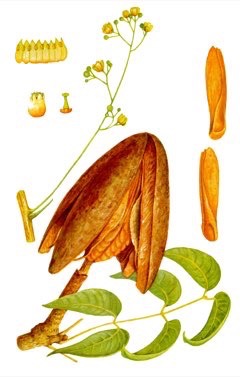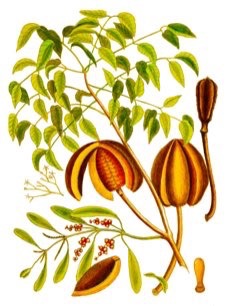 |
|
http://www.edibleplants.org |
 |
| http://www.edibleplants.org |
Translate this page:
Summary
Swietenia mahagoni or Mahogany is an evergreen or briefly deciduous tree commonly found in Southeastern part of North America. It grows up to 30-35 m tall with a large, round crown and short bole that can be up to 100 cm in diameter. The leaves are pinnate with four to eight leaflets each. The flowers are small and produced in panicles. The fruits are woody capsule containing plenty of winged seeds. No plant part is edible. Decoction of the stem bark is taken orally against diarrhea and dysentery, and used to induce hemorrhage. Bark decoction is used externally to dress wounds caused by firearms. Though often used as a shade tree, Mahogany is also used primarily for its high-quality wood. It is medium-weight, highly durable, resistant to most wood-rotting fungi, and easy to work. It is used commonly for high-quality furniture, joinery, boars, carvings, musical instruments, etc. Seeds yield oil which has commercial uses.
Physical Characteristics

 Swietenia mahagoni is an evergreen Tree growing to 25 m (82ft) by 25 m (82ft) at a fast rate.
Swietenia mahagoni is an evergreen Tree growing to 25 m (82ft) by 25 m (82ft) at a fast rate.
See above for USDA hardiness. It is hardy to UK zone 10 and is frost tender. The flowers are pollinated by Bees, Moths, Thrips. The plant is self-fertile.
Suitable for: medium (loamy) and heavy (clay) soils, prefers well-drained soil and can grow in heavy clay and nutritionally poor soils. Suitable pH: mildly acid, neutral and basic (mildly alkaline) soils and can grow in saline soils.
It cannot grow in the shade. It prefers moist soil and can tolerate drought.
UK Hardiness Map
US Hardiness Map
Synonyms
Cedrela mahagoni L. Cedrus mahogani Mill. Swietenia acutifolia Stokes Swietenia fabrilis Salisb.
Plant Habitats
Edible Uses
References More on Edible Uses
Medicinal Uses
Plants For A Future can not take any responsibility for any adverse effects from the use of plants. Always seek advice from a professional before using a plant medicinally.
Antibacterial Antidiarrhoeal Antiseptic Appetizer Astringent Dysentery Febrifuge
The stem bark is considered to be antiseptic, astringent and febrifuge[303 , 348 ]. It is taken orally as a decoction for diarrhoea and dysentery, as a source of vitamins and iron, and as a medicine to induce haemorrhage. When the bark is steeped to a red liquid, it is taken to clear the blood, increase appetite, and restore strength in cases of tuberculosis[303 , 348 ]. A decoction of the bark is used externally to dress wounds caused by firearms[348 ]. Methanol extracts of the bark showed inhibitory activity on HIV-1 protease[299 ]. Ether extracts of seeds inhibited platelet aggregation, probably due to the presence of tetranortriterpenoids[299 ].
References More on Medicinal Uses
The Bookshop: Edible Plant Books
Our Latest books on Perennial Plants For Food Forests and Permaculture Gardens in paperback or digital formats.

Edible Tropical Plants
Food Forest Plants for Hotter Conditions: 250+ Plants For Tropical Food Forests & Permaculture Gardens.
More

Edible Temperate Plants
Plants for Your Food Forest: 500 Plants for Temperate Food Forests & Permaculture Gardens.
More

More Books
PFAF have eight books available in paperback and digital formats. Browse the shop for more information.
Shop Now
Other Uses
Charcoal Dye Furniture Plant breeding Tannin Wood
Shade tree. Street tree. Public open space. Xerophytic. Agroforestry Uses: Farmers generally plant the species along garden boundaries or around the courtyard, where it provides deep shade[303 ]. The tree is used in reforestation projects, as a shade tree in young plantations of other timber species and as a shade tree in coffee and cacao plantations[299 , 418 ]. Other Uses An oil can be extracted from the seed kernels which might be of some commercial value[299 ]. The bark is a source of tannins and has been used for dyeing[299 ]. The crushed fruit shells have been used as a potting medium[299 ]. The heartwood is reddish or pinkish, the colour darkening with age to a deep red or brown; it is distinctly demarcated from the up to 40mm wide band of usually yellowish sapwood. The grain is interlocked, sometimes straight; texture fine to moderately coarse; surfaces are glossy, and the wood is often nicely figured because of the irregular grain. The wood is medium-weight, comparatively soft, very durable, but not considered suitable for applications in contact with the ground. Graveyard tests in Indonesia showed an average service life in contact with the ground of 3.3 years. The wood is resistant to most, but not all, wood-rotting fungi, and is liable to termite attack. The wood seasons well, without much checking or distortion and kiln dries satisfactorily when moderate schedules are used. Rates of shrinkage are low and uniform, after drying it is stable in service. It saws, planes and moulds easily in both green and dry condition; in general it finishes to an exceptionally smooth, lustrous surface, but a woolly surface may occur on bands of reaction wood or interlocked grain; finishing is easy and the wood takes an excellent polish, gluing and nailing properties are good, but discoloration in contact with iron, copper and brass may occur under humid conditions. The wood slices and rotary cuts into fine and decorative veneer, without preliminary treatment, at a peeling angle of 92?. The wood is therefore the choice for high-quality furniture and cabinetwork, joinery, boats and pattern work. Wood carvers use a significant amount of the wood in turnery and sculpture[303 ]. The wood's outstanding technical qualities make it particularly suitable for precision woodwork such as models and patterns, instrument cases, clocks, printer?s blocks and parts of musical instruments; for these purposes, uniform straight-grained material is used. Other minor uses include burial caskets, novelties and expensive toys[299 ]. In Haiti, much of the branch wood and most of the crooked stems are converted to charcoal, particularly in regions isolated from urban markets by poor roads[303 ].
Special Uses
References More on Other Uses
Cultivation details
A plant of the moist to humid tropics, where it is found at elevations from 50 - 1,500 metres[303 ]. It grows best in areas where annual daytime temperatures are within the range 24 - 32°c, but can tolerate 16 - 36°c[418 ]. It prefers a mean annual rainfall in the range 1,000 - 2,000mm, but tolerates 800 - 2,500mm[418 ]. The best development of the trees has been observed in areas receiving the lower rainfall range of 1,000 - 1,500 mm, in localities not far from the sea, and at elevations near sea level[303 ]. Young plants grow best in dappled shade, requiring more light as they grow larger[303 ]. The plant thrives best on deep, rich soil and avoids stiff, heavy soils in the wild; well-drained sandy soils are best[303 ]. It is a complete failure in dry localities and poor soils[303 ]. Prefers a pH in the range 6 - 7, tolerating 5.5 - 8[418 ]. Young trees have straight and slender stems, and branches are formed 2 - 3 metres above the ground with a position oblique to the main stem. Initial growth is fast, depending on site conditions[299 ]. Flowering and fruiting are regular and annual, varying according to climate but taking place shortly before the rainy season. The tree fruits well and produces fertile seeds, sometimes as early as at 20 years of age, although usually it does not seed until it is 30-40 years old[303 ]. Seed production varies according to site and year[303 ]. This species hybridizes with S. Macrophylla and S. Mahagoni. Hybridization has been confirmed by cytological studies[303 ]. Flowering Time: Late Winter/Early Spring. Bloom Color: White/Near White. Spacing: 20-30 ft. (6-9 m).
References Carbon Farming Information and Carbon Sequestration Information
Temperature Converter
Type a value in the Celsius field to convert the value to Fahrenheit:
Fahrenheit:
The PFAF Bookshop
Plants For A Future have a number of books available in paperback and digital form. Book titles include Edible Plants, Edible Perennials, Edible Trees,Edible Shrubs, Woodland Gardening, and Temperate Food Forest Plants. Our new book is Food Forest Plants For Hotter Conditions (Tropical and Sub-Tropical).
Shop Now
Plant Propagation
Seed - it has a short viability and is best sown as soon as ripe[303 ]. Sow in a nursery seedbed with some overhead shade. The seed wing should be broken, since this facilitates germination[303 ]. Healthy seeds start germinating about 15 days after sowing[299 ]. When the seedlings are 3 - 4 weeks old, remove the overhead shade, giving only lateral shade[299 ]. In Java and Haiti, where abundant natural regeneration is found under trees and in the vicinity of almost all the older plantations, most farmers use wildlings for planting material[303 ]. Without any special treatment, seeds lose much of their viability in 3 months and almost entirely in 6 months[303 ]. Dried in the sun and sealed in airtight containers, they remain fairly viable for over 6 months[303 ]. Viability can be maintained in hermetic air-dry storage at room temperature for 1 year[303 ]. Cuttings from plants up to 3 years old are usua;;y successful, but do not work well from older plants[299 ].
Other Names
If available other names are mentioned here
mahogany|mahogany
Native Range
NORTHERN AMERICA: United States (Florida) SOUTHERN AMERICA: Bahamas, Cuba, Dominican Republic, Haiti, Jamaica
Weed Potential
Right plant wrong place. We are currently updating this section.
Please note that a plant may be invasive in one area but may not in your area so it's worth checking.
Conservation Status
IUCN Red List of Threatened Plants Status : Status: Endangered A1cd

Growth: S = slow M = medium F = fast. Soil: L = light (sandy) M = medium H = heavy (clay). pH: A = acid N = neutral B = basic (alkaline). Shade: F = full shade S = semi-shade N = no shade. Moisture: D = dry M = Moist We = wet Wa = water.
Now available:
Food Forest Plants for Mediterranean Conditions
350+ Perennial Plants For Mediterranean and Drier Food Forests and Permaculture Gardens.
[Paperback and eBook]
This is the third in Plants For A Future's series of plant guides for food forests tailored to
specific climate zones. Following volumes on temperate and tropical ecosystems, this book focuses
on species suited to Mediterranean conditions—regions with hot, dry summers and cool, wet winters,
often facing the added challenge of climate change.
Read More
Expert comment
Author
(L.) Jacq.
Botanical References
Links / References
For a list of references used on this page please go here
A special thanks to Ken Fern for some of the information used on this page.
Readers comment
| Add a comment |
|
If you have important information about this plant that may help other users please add a comment or link below. Only comments or links that are felt to be directly relevant to a plant will be included. If you think a comment/link or information contained on this page is inaccurate or misleading we would welcome your feedback at [email protected]. If you have questions about a plant please use the Forum on this website as we do not have the resources to answer questions ourselves.
* Please note: the comments by website users are not necessarily those held by PFAF and may give misleading or inaccurate information.
To leave a comment please Register or login here All comments need to be approved so will not appear immediately.
|
Subject : Swietenia mahagoni
|
|
|
|